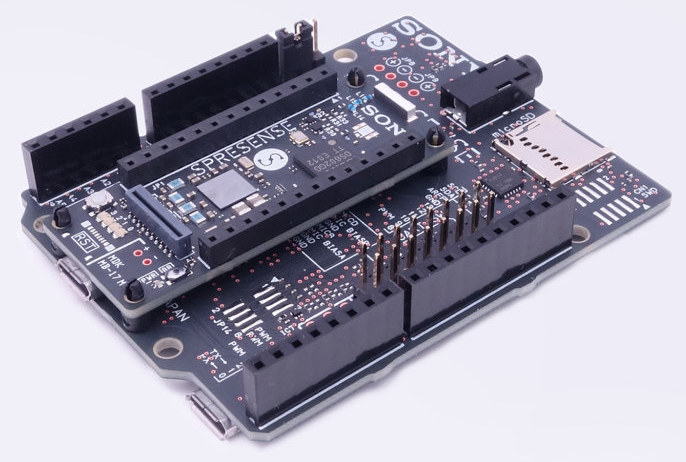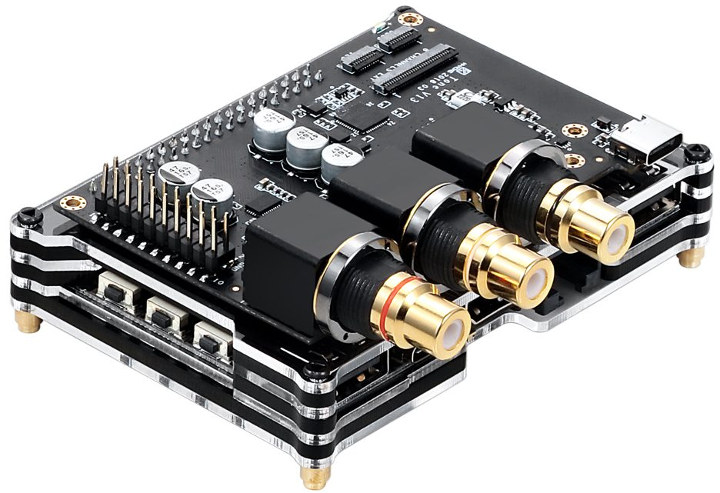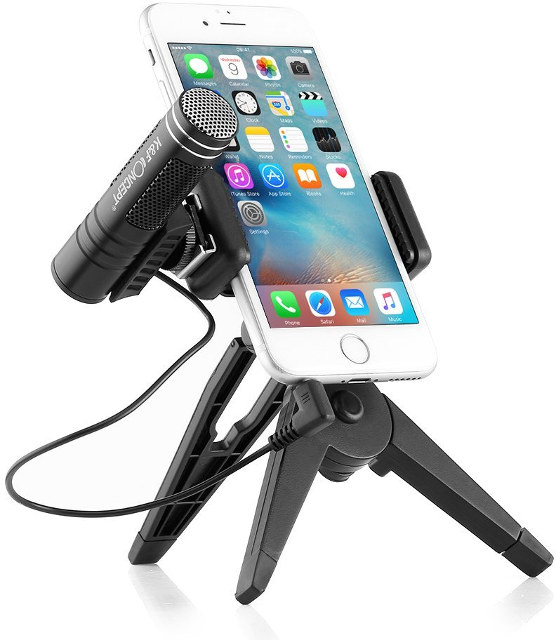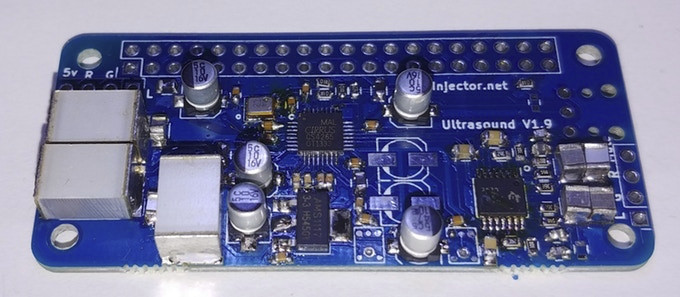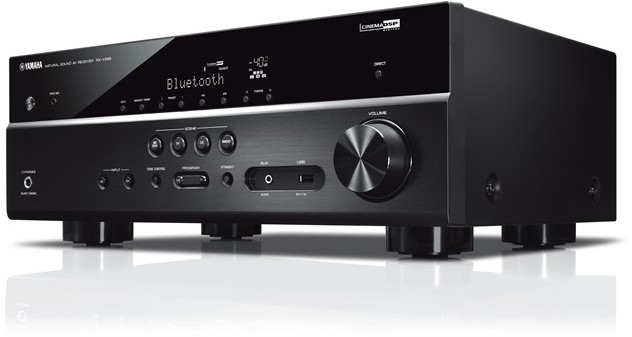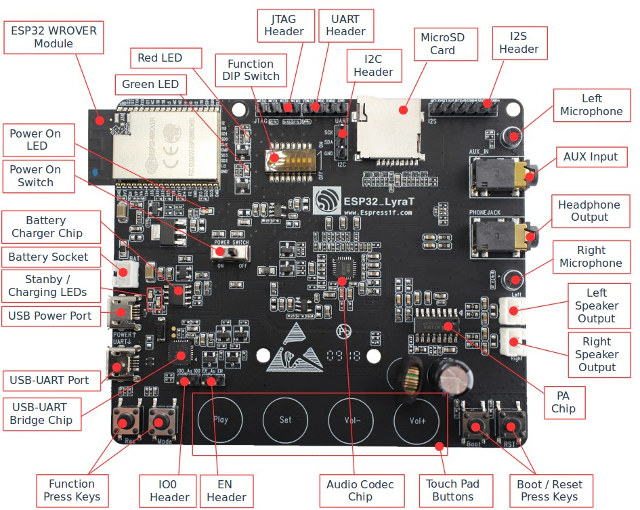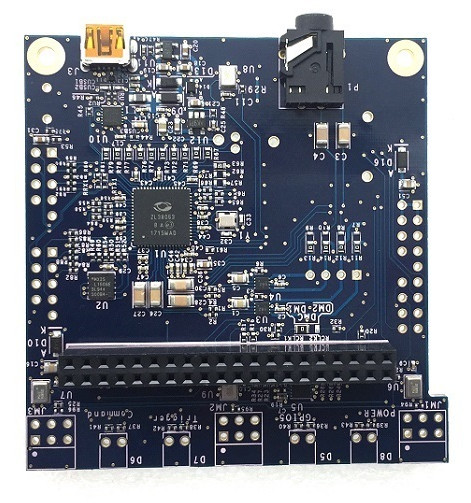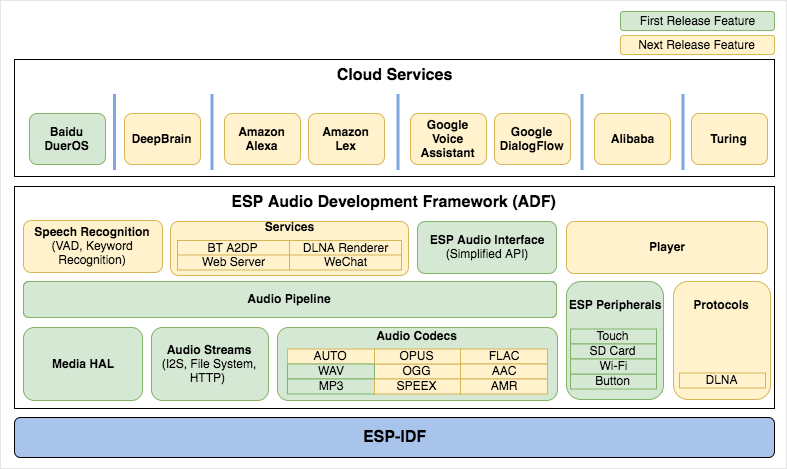Last year, we covered Sony Spritzer, an Arduino compatible with a Sony hexa-core Arm Cortex-M4F micro-controller, a built-in GNSS receiver, and an audio codec. The product page for this product is now gone, but it appears Sony only renamed it to SPRESENSE, made some design modifications, and is ready to launch the main board for 5,500 JPY (~$50), and the extension board for an extra 3,500 JPY ($32) on July 31, 2018. Sony SPRESENSE main board (CXD5602PWBMAIN1) specifications: MCU – Sony CXD5602 ARM Cortex-M4F ×6 micro-controller clocked at up to 156 MHz with 1.5MB SRAM Storage – 8MB Flash Memory GNSS – GPS & GLONASS Audio – 3.5mm audio jack Expansion I/Os Digital I/O Pins – GPIO, SPI, I2C, UART, PWM, I2S Analog Pins – 2ch (0.7V range) Camera interface USB – 1x micro USB port for programming and power Power Supply – 5V via micro USB port Dimensions – […]
Khadas Tone High Resolution Audio Board is Designed for Khadas VIM/VIM2, PCs, and Other SBCs
Khadas VIM and Khadas VIM2 are development boards powered respectively by Amlogic S905x and S912 processors that come with decent software support. The company also provides application specific add-on boards for their SBCs, and a while ago, I reviewed VIM2 with their dual tuner board and showed how to stream videos from my satellite dish or terrestrial antenna to the local network. Their latest solution is Khadas Tone board for high-quality audio applications. Khadas Tone “VIMs Edition” specifications: Multicore MCU – XMOS XU208-128-QF48 with 8x xCORE-200 cores up to 500 MIPS DAC – ES9038Q2M 32-Bit Stereo Mobile Audio DAC THD+N – ≤ 0.000337% @1KHz SNR – ≥ 120dB @ 10Hz~20KHz DNR – ≥ 120dB @ 10Hz~20KHz Crosstalk – ≥ 127dB @ 10Hz~20KHz Frequency Response – ±0.08 dB @ 10Hz~20KHz Sampling Frequency PCM: Up to 768KHz @ 32bit DSD: Up to DSD256 @ 1bit Clock Jitter Reference Clock Jitter < 3ps […]
This Smartphone Tripod with Microphone is Designed for Audio/Video Recording
More and more use cases are being handled by smartphones, and we’ve recently seen smartphone stands helping with specific applications such as keyboard and mouse mobile gaming, or a flexible lazy holder allowing you to carry the phone around hands-free among other things. I’ve now come across another smartphone stand that’s designed for audio recording with a built-in microphone, and that could be useful to video bloggers, or others requiring high(er) quality audio recording on the go. Specifications & key features: Microphone Material – ABS + Aluminum alloy Monomer: Electrets condenser Directivity – Heart-shaped Test voltage: 1.5V Impedance: 220Ω Sensitivity: -39db±3dB (0dB=1V/Pa at 1kHz) S/N: ≥65dB 3.5mm audio jack connector 360 degree tube rotation design for microphone holder Foldable tripod with adjustable clamp for smartphone The accessory works with any phones that comes with a 3.5mm audio jack, or adapter for phones with a USB type C port only. The […]
Flatmax Studio Audio Injector Ultra Sound Card is Designed for Raspberry Pi Boards (Crowdfunding)
Flatmax Studio has launched several audio cards for Raspberry Pi boards on Kickstarter in recent years, and their latest board is called “Audio Injector Ultra Sound Card”. The board is said to give high fidelity input and output audio @ 192 kHz, is equipped with digital output (S/PDIF) and offers dual microphone capability. An extra balanced HAT – will send and receive balanced stereo input and output – is also available. Specifications: Direct Inputs – Unpopulated Analogue Connectors (stereo RCAs provided) Direct Outputs – Unpopulated Analogue Connectors (stereo RCAs provided), Digital Optical SPDIF (Optical transducer provided) Potentiometer Inputs – Unpopulated Connectors and potentiometer (stereo pot. not provided). Potentiometer Outputs – Unpopulated Connectors and potentiometer (stereo pot. not provided). Microphone – 2x high quality ultrasound (model – SPU0410LR5H) surface mount microphones populated Audio Codec – Cirrus Logic CS4265 stereo codec Sample rate – 192 kHz, 24 bit Jitter control – Low […]
Yamaha RX-V385 A/V Receiver to Support eARC (part of HDMI 2.1 specifications)
HDMI 2.1 promises features such as 8K/10K video output, dynamic HDR, or enhanced audio return channel (eARC), but so far I had not seen any hardware boasting support for the new specifications. It’s not really surprising, as the HDMI Compliance Test Specifications (CTS) for HDMI 2.1 is expected to be released in stages starting in Q2 2018. While I have yet to see any HDMI 2.1 capable TV, Yamaha is already showing off a 5.1 A/V receiver allegedly HDMI 2.1 via their upcoming RX-V385 model that will be sold for $299.95 in the US. Key features listed by the company: 5.1-Channel powerful surround sound Bluetooth for wireless connectivity HDMI 2.1 with HDCP 2.2 (4 in/1 out) 4K Ultra HD support, HDR10, Dolby Vision, Hybrid Log-Gamma and BT.2020 YPAO auto-calibration technology for ideal sound That looks good, and if we look into the details specifications we can see HDMI eARC (part […]
ESP32-LyraT Speech Recognition Board Sold for 22 Euros
Just last week, we wrote about Espressif ESP-ADF Audio development framework that can be used to develop smart speakers and other audio applications with ESP32 boards. There was only one board with documentation at the time however: ESP32-Lyra-T. One tiny problem: it was not for sale just yet, but today Olimex has announced the board is in stock, selling it for 22 Euros. Main features: Wireless module – ESP32-WROVER module with WiFi and Bluetooth LE Audio Many audio inputs – Wi-Fi, BT-audio, DLNA, 3.5mm audio Line-in 3.5mm headphone jack 2x microphones Speaker connectors Storage – micro SD slot Debugging – JTGA header, USB UART Misc – Touch sense buttons, function/boot/reset keys, DIP switch for configuration Power – 5V via micro USB port; battery header + charger chip You’ll find documentation on Espressif website (user guide) as well as on Github’s ESP-ADF (getting started guide). Jean-Luc Aufranc (CNXSoft)Jean-Luc started CNX Software in […]
Banana Pi BPI-AI-Voice is a $169 Speech Recognition Development Kit based on MicroSemi ZL38063
SinoVoIP has just launched BPI-AI-Voice development platform for speech recognition on Aliexpress for $169, and excluding the different PCB color, it is a clone of the official $299 Microsemi AcuEdge Development Kit for Amazon AVS, which is based on MicroSemi ZL38063 audio processor and comes with two microphones. BPI-AI-Voice key features: Audio Processor – MicroSemi ZL38063 Storage – U2 SPI flash to store ZL38063 firmware Audio 4x on-board digital microphones (AKU441) supporting a 2 microphone configuration for 180° and 360° audio pick-up. 2x low cost class D audio amplifier (NCP2820) Expansion Headers JMMA1 audio header for digital microphone, analog out, and 3 GPIOs JM1-4 digital microphone headers for off-board microphones 40-pin P2 header to connected to Raspberry Pi 3 (I2S, SPI and 8x GPIO used) Debugging – JAIB2/2 auto tuning headers, micro USB port. Power Supply – 5V via micro USB port Dimensions – 70 mm × 66 mm Temperature […]
Espressif ESP-ADF Audio Development Framework for ESP32 Supports Baidu DuerOS, and Soon Amazon Alexa, Google Assistant, etc…
Espressif Systems have been working on audio applications like Smart Speakers based on ESP32 WiSoC with hardware development kits like ESP32-LyraTD-MSC Audio Mic HDK, and I could test it with Baidu DuerOS using Mandarin language. However, at the time (February 2018), there was not much else that could be done with the hardware kit, since no corresponding ESP32 audio software development kit had been made available. This has now changes since Espressif has just released ESP-ADF Audio Development Framework on Github. The framework will support the development of audio applications for the Espressif Systems ESP32 chip such as: Music player or recorder handling MP3, AAC, WAV, OGG, AMR, SPEEX … audio formats Play music from network (HTTP), storage (SD card), Bluetooth A2DP/HFP Integration with Media services such as DLNA, Wechat, etc.. Internet Radio Voice recognition and integration with voice services such as Alexa, DuerOS, Google Assistant As we can see […]


